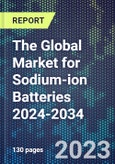The sodium-ion battery (SIB) market is rapidly gaining momentum as it promises to be a more sustainable and cost-effective alternative to lithium-ion batteries. The market is at an early-stage, but is growing fast, and is ramping up in 2023. Commercialization of SIB is moving much faster than was originally expected and they will be key components in Small Electric Vehicle (EV) and Long-duration Energy Storage applications. Among other advantages over incumbent Lithium-ion batteries (LIB), SIBs offer lower raw material costs and sustainability.
Key SIB Market Drivers include:
- Lower raw material costs - Sodium is abundant compared to constrained lithium supplies, reducing input costs.
- Improved sustainability - Avoidance of scarce lithium and cobalt resources.
- Increasing R&D - Major advances in anode, cathode and electrolyte materials.
- Government funding - Subsidies and investments aimed at advancing SIB tech.
- EV applications - Automakers developing SIBs for more affordable EVs.
BYD spin-off FinDreams has recently entered a joint venture agreement with Huaihai Holding Group to create the world's largest sodium-ion battery factory for small electric vehicles. Leading power battery manufacturer CATL will begin mass production of sodium-ion batteries for vehicles in Q4 2023 and other battery and automotive manufacturers are increasing commercial activity. SIBs are expected to gain share in:
- Small electric vehicles and short-range transportation.
- Large-scale stationary storage for renewable energy.
- Backup power supplies and off-grid energy storage.
Report contents include:
- Market drivers and challenges.
- Comparative analysis to other battery types.
- Analysis of materials and components in Na-ion batteries.
- Cost breakdown and analysis.
- Market developments, production, funding and investments 2020-2023.
- The market in China.
- Market value chain analysis.
- Analysis of main players and benchmarking.
- Capacities to 2034.
- Global patent landscape.
- Market analysis of markets for Na-ion batteries:
- Large-scale stationary grid storage.
- Stationary batteries.
- Electric vehicles.
- Electric boats.
- Consumer electronics.
- 50 company profiles. Company profiles include products, materials utilized in cathodes & anodes, cell densities, cycle life, target markets and production plans. Companies profiled include Altris AB, CATL, Faradion, HiNa Battery, Kite Rise Technologies GmbH, Natron Energy, Tiamat Energy and Weifang Energy.
This product will be delivered within 1-3 business days.
Table of Contents
Companies Mentioned (Partial List)
A selection of companies mentioned in this report includes, but is not limited to:
- Altech Batteries Ltd.
- Altris AB
- AMTE Power
- BASF
- Biwatt Power
- BenAn Energy Technology
- Broadbit Batteries Oy
- Build Your Dreams (BYD)
- Contemporary Amperex Technology Co Ltd (CATL)
- CAPCHEM
- CBAK Energy Technology, Inc.
- Central Glass Co., Ltd.
- Cham Battery Technology
- Chengdu Baisige Technology Co., Ltd.
- China Sodium-ion Times
- DFD
- EVE Energy Co., Ltd
- Exencell New Energy
- Faradion Limited
- Farasis Energy
- Geyser Batteries Oy
- Great Power Energy
- Guoke Tanmei New Materials
- HiNa Battery Technologies Limited
- Horizontal Na Energy
- Hua Na New Materials
- Indi Energy
- Inna New Energy
- Janaenergy Technology
- Jiana Energy
- Kite Rise Technologies GmbH
- Lepu Sodium Power
- Libode New Material
- Li-Fun Technology
- LiNa Energy
- Lucky Sodium Storage
- Nacoe Energy
- Natrium Energy
- Natron Energy
- NGK Insulators
- Nippon Electric Glass
- Paragonage
- Qi Na New Energy
- Ronbay Technology
- Sodion Energy Pte. Ltd.
- Stora Enso Oyj
- Svolt Energy
- Tiamat Energy
- Weifang Energy Technology Co., Ltd.
- Zoolnasm (Zhongna Energy)
Methodology

LOADING...








